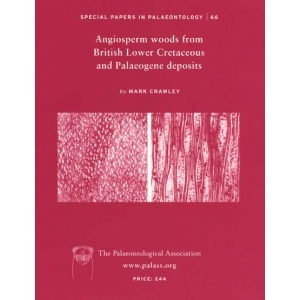
Special papers in Palaeontology: 66
<br />2001
<br />
<br />Angiosperm woods from British lower Cretaceous and Palaeogene deposits.
<br />M Crawley
<br />
<br />100 pp., 13 pls, 18 figs, 16 tabs.
<br />
<br />ABSTRACT. Four of the five putative British Lower Cretaceous angiospenn woods Aptiana, Cantia. Hythia. Sabulia and Wobumia (Stopes 1912. 1915) are re-evaluated. Aptiana radiata Stopes, 1912 is accepted as Lower Cretaceous (Aptian! Albian) and is, therefore, regarded as the only valid British Cretaceous angiospenn wood. New material of Cantia, Hythia and Sabulia has allowed an original provenance of Palaeogene for all specimens representing these taxa. They also show similarities to Betulaceae (Cantia). Icacinaceae, Platanaceae or Fagaceae (Hythia) and Lauraceae (Sabulia). Fifteen new species are described: Anacardioxylon maidstonense, Apocynoxylon? oldhavenense, A. sapotaceoides, Canarioxylon lewisii. Castanoxylon philpii, Dryoxylon calodendrumoides. Entandrophragminium lewisii, Eupharbioxylon hemense, Flacourtioxylon oldhavenense, Ilicoxylon? preslWichii. Meliaceoxylon collinsonae. Paraphyllanthoxylon chievleyense, Polyalthioxylon oldhavenense, Tetrapleuroxylon oldhavenense and Tilioxylon lueheafonnis. Three new combinations of Palaeogene wood are also described. The new species and new combinations show feature sets found in Recent Anacardiaceae, Annonaceae, Aquifoliaceae, Apocynaceae, Burseraceae, Caesalpinaceae, Euphorbiaceae, Fagaceae, Flacourtiaceae, Hamamelidaceae, Meliaceae, Lauraceae. Lecythidaceae, Sapotaceae and Tiliaceae. All British Palaeogene material is reviewed for wood and tree evolution, palaeobiology, palaeobiogeography and palaeoclimatology. The anatomical results show increased diversity by the latest Palaeocene, including the oldest known wood with spiral thickening of the vessels, and support a trend of increasingly warm temperatures with less seasonality and structures more typical of Recent tropical regions by Late Palaeocene/Early Eocene times in the British area.